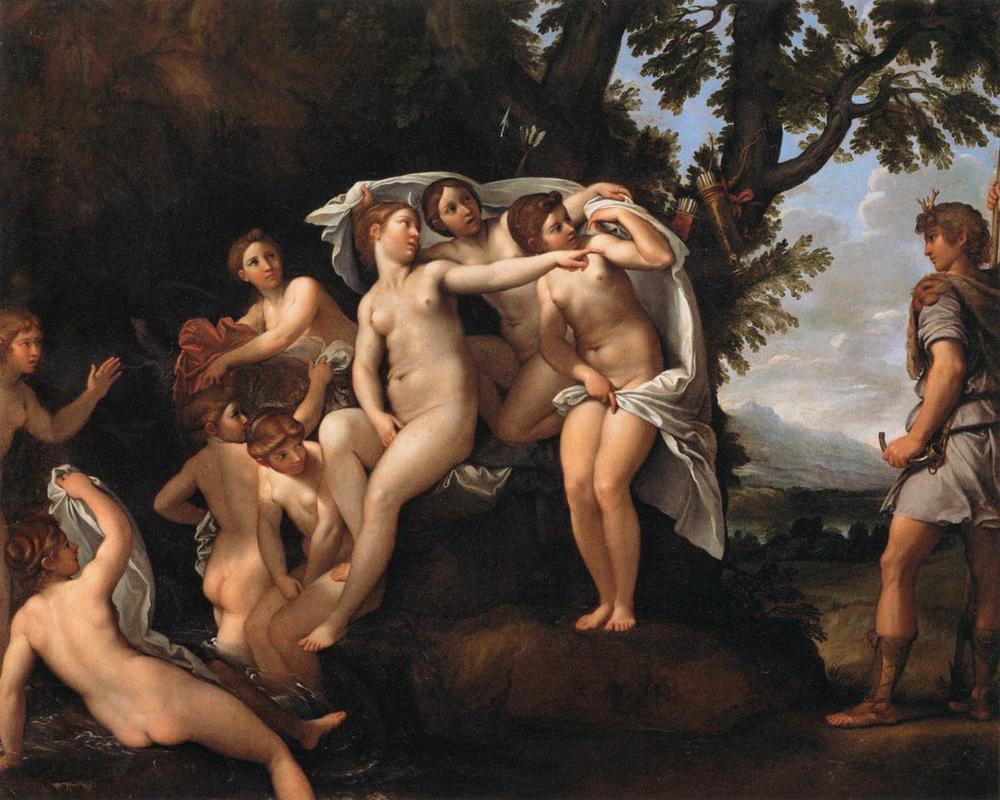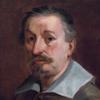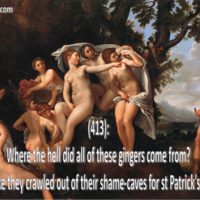More about Diana and Actaeon

Sr. Contributor
The soft playfulness of Albani's work Diana and Actaeon belies the darkness, vulnerability, and empowerment within the larger story.
The myth of Diana and Actaeon, from Ovid’s Metamorphoses, is such a classic-but-dark story of female empowerment that it has been depicted again and again. The short version of the story is that stunning beauty Diana, goddess of the hunt, is enjoying a bathing day with her girlfriends when she catches hunter Actaeon playing Peeping Tom. Horrified, irritated, or both she aims to go after him, splashing him with water that turns him into a deer. She gets the last laugh when his own hounds, seeing him as a deer, hunt him down and kill him. If you’ve ever cringed at the idea of Bambi in the eye of a rifle, and particularly if you’re living a sentient-being-friendly vegan lifestyle today, you can’t help but think that for so many different reasons Actaeon got what was coming to him.
There’s something delightfully twisted about this retribution. Perhaps that’s why it’s such a popular art subject. Diana and Actaeon's story has been painted by Titian, Jacob Jordaens, and Giuseppe Cesari. Each artist has layered their own fantasies about naked bathing virgins and leering hunters over their version of the work. It’s no different in this version by Francesco Albani. Just like so many of the others, the narrative seems to be less about Actaeon’s inappropriate behavior and more about the opportunity to paint naked women in their full glory.
In fact, these paintings seem to miss the most important point of the story: the transformation of the man into a deer who gets viciously hunted down by his own dogs. If you didn’t know the background story, you’d probably never guess that’s what this painting is about. Albani’s painting shows a tiny pair of antlers sprouting about the villain’s head, but otherwise we don’t really get the gist of it at all. He is depicted more as a playful man-child than a grown man ogling naked women.
In fairness, Albani was a man of his times. Much of his work was commissioned, so he certainly had to please his patrons. Diana and Actaeon was painted for the Duke of Mantua. And perhaps there’s something to be said for his intention here, as he depicts the beauty of the women lounging naked amongst one another. Right around the same time that he painted Diana and Actaeon, a new group of Dutch artists called the Bamboccianti were emerging with a form of work emphasizing “low-life genre” scenes. Albani was one of several highly-trained Italian masters who denigrated their work, disgusted that they would turn to base depictions of “real life” instead of the loftier visions of the imagination. So, it could be said that he idealized Diana and the women in the painting. Indeed, his contemporaries compared him to a poet, celebrating the delicate and gentle nature of his subjects. We can take that with a grain of salt; Diana was a strong woman fighting for her right to bathe privately here. Nevertheless, it speaks to the style of the work.
Another way to look at this myth is through the lens of vulnerability. Feminism knows that a world that doesn’t treat women well is also a world that’s not good for men. When any group’s rights are trampled upon, everyone becomes more vulnerable. To that end, Albani’s version of the myth might be the most accurate. Diana and her friends are vulnerable in their nudity, although they stand up for themselves as best they can. And Actaeon, too, is vulnerable, depicted in seeming innocence here, about to become the weakest of stags and to lose his life. Relationships between men and women have been complicated throughout time, and perhaps this speaks to that, intentionally or not.
Sources
- Hardie, Philip. “The Cambridge Companion to Ovid.” 2002. Cambridge University Press.
- Macauley, Alastair. “His Motives May Vary, but, Alas, Actaeon Is Doomed to Suffer the Same Fate.” The New York Times. Mar 16, 2010. Retrieved June 25, 2019 from https://www.nytimes.com/2010/03/17/arts/music/17actaeon.html
- Waters, Clara Erskine Clement. “Painters, Sculptors, Architects, Engravers, and Their Works: A Handbook.” 1880. Houghton Mifflin & Co.
- Zirpolo, Lillian H. “Historical Dictionary of Baroque Art and Architecture.” 2018. Rowman & Littlefield.













